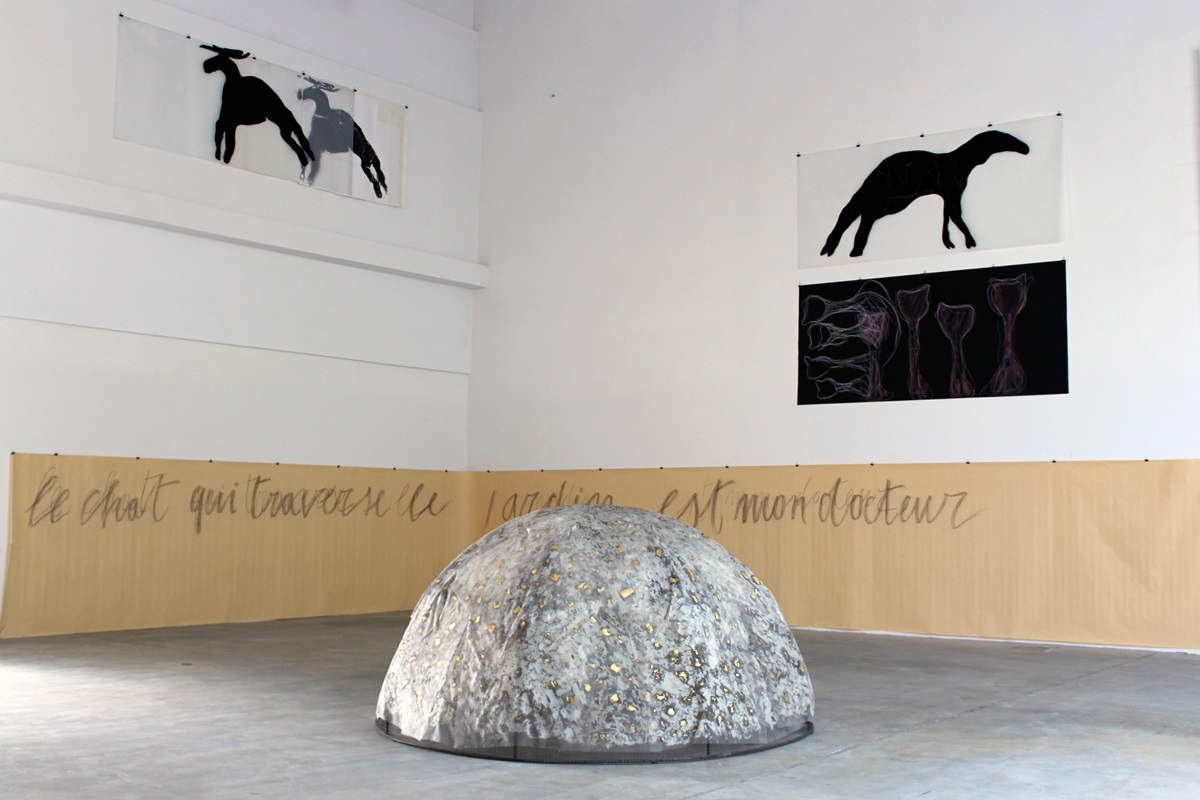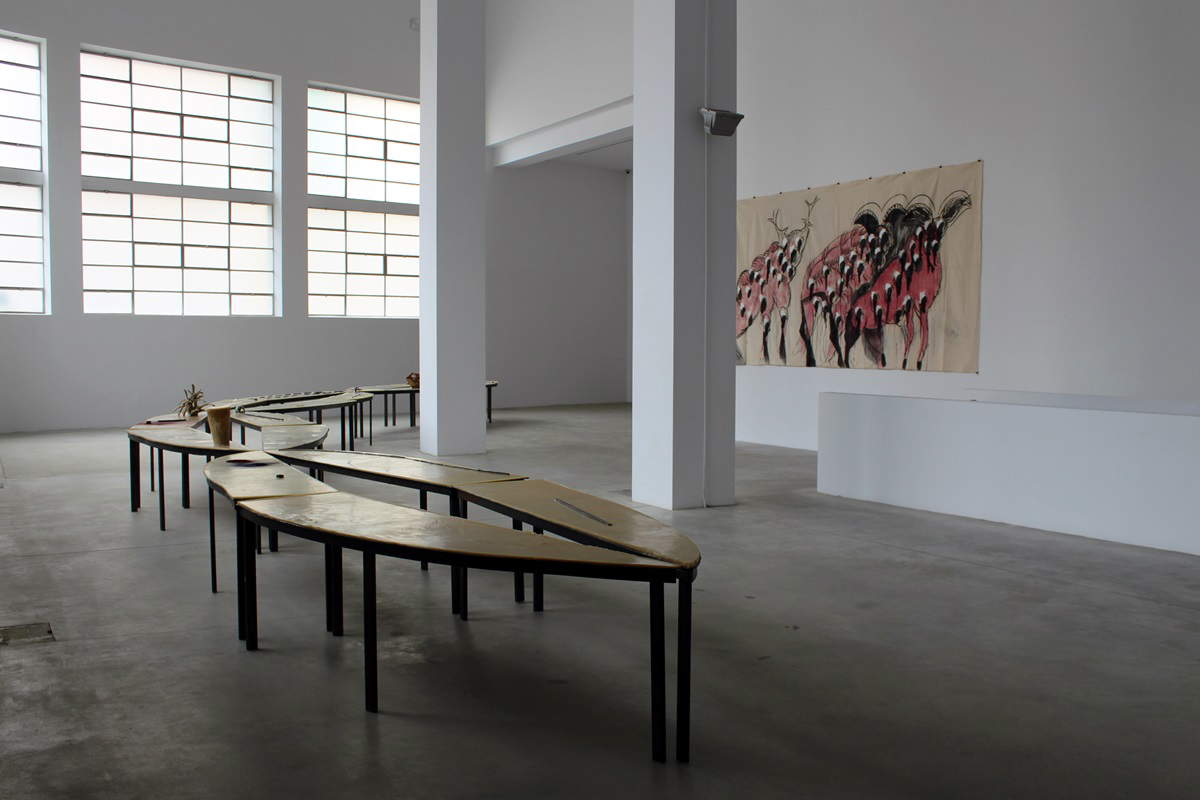The Merz Foundation in Turin presents, from July 8 to October 6, 2024, the exhibition Qualcosa che togliglie il peso dedicated to Mario Merz (Milan, 1925-2003). The exhibition presents a varied selection works by Mario Merz. The centerpiece of the exhibition is the work Four Tables in the Form of Magnolia Leaves (1985), exhibited here for the first time in Europe, made on the occasion of the solo show by Sperone Westwater and Leo Castelli in New York. Something that takes the weight off stems from the concept described by anthropologist Claude Lévi-Strauss and related to the need to identify the profound nature behind patterns in order to get to the basis of human thought, which in its diversity is always defined by laws that escape the passage of time and the variety of environments. The phrase that gives the exhibition its title, Something that takes the weight off, was also extrapolated from a writing by Mario Merz and relates to this need to look at nature and the passage of time in order to achieve a sense of conceptual lightness, which is found in the nucleus of works presented. The igloo Untitled (1997), immersed in the atmosphere of the exhibition spaces is presented as a cosmic dome that, through its golden leaves, breathes the real light of the environment and releases golden reflections. The concept of light also refers to the use of neon, which directs the mind to unsuspected details, emphasizing natural and convivial elements as in the case of L’horizont de lumière traverse notre vertical du jour (1995) in which vases filled with wine and honey together highlight a reference to time and the body. This attention to nature transformed into culture finds expression in Four tables in the form of magnolia leaves (1985) to represent a magnificent union of elements and signifiers.
Drawings and canvases on the walls transform the rooms into a territory in which it is possible to experience being in the world, consistent with Mario Merz’s idea of inhabiting a space, not so much of “making” an exhibition. A video interview with curator Herald Szeemann, made in 1985 on the occasion of his solo show at the Kunsthaus Zurich, concludes the exhibition. Accompanying the exhibition, the days of September 18 and 19, 2024, will be devoted to meetings, conferences and various moments open to the public dedicated to the figure of Merz. Among them, the first volume of the catalog raisonné of the artist’s work, dedicated to igloos, will be presented. The project is realized thanks to the support of the General Directorate for Contemporary Creativity of the Ministry of Culture as part of the Italian Council (2023) program.


Mario Merz, born in 1925, moved while still a child to Turin with his family, of Swiss origin. During the years of World War II he abandoned his university studies in Medicine and actively participated in the anti-fascist struggle. Arrested in 1945 while leafleting, he began drawing in prison. After liberation, also encouraged by his friend Luciano Pistoi, he decided to devote himself entirely to painting, and in 1954 he inaugurated his first solo exhibition, at the La Bussola Gallery in Turin, where he presented paintings with an expressionist slant.
In the mid-1960s Merz’s research developed and evolved toward an experimentation that led him to create the “volumetric paintings” (Mila Pistoi), constructions of canvases that incorporate object trouvés, organic or industrial materials, whose inclusion in the work contributes to placing the artist among the protagonists of Arte Povera. Objects of use the iron rod, the wire mesh, the glass, quotations not only literary, manifest themselves as energies hitherto neglected by artistic practice that Merz frees in “a sum of inner projections on objects,” sometimes translating them “directly into objects” (Germano Celant), reinterpreting them in repositioning them in a panorama of new forms and pronouncements. It is constellated by the igloo (1969) and the table (1973): the one “ideal organic form, at the same time world and small house” that the artist claims to inhabit, absolute space not shaped but “hemisphere resting on the ground”; the other “the first thing for the determination of space, piece of raised earth, like a rock in the landscape.” Igloos and tables are, as well as primary and archetypal structures, aesthetic and socio-political statements together, in their representing the ultimate overcoming of the painting and the artist’s solipsism. Since the 1970s, the Fibonacci number series has been a fixed presence in Merz’s work. The artist interprets it as an emblem of the dynamics relating to the growth processes of the organic world, placing the figures made in neon in his works, from the preview of the Fibonacci Santa Giulia, hanging in the kitchen of hisTurin dwelling (1968), to the underground Suite along streetcar line 1 in Strasbourg (1994), from the proliferating tables designed for John Weber (1973) to the crowd of igloos present at the Kunsthaus in Zurich (1985) and the Salpêtrière in Paris (1987) to the interpenetration between tables and igloos (from the Capc in Bordeaux, 1987, to the Stedelijk in Amsterdam, 1994).
The recurrence of certain forms all referable to the spiral, such as the triangle, the cone, the vortex, visualized artistically, inferred or glimpsed in an infinite series of mostly organic elements, such as snails, branches, leaves, pine cones, horns, is linked to the Fibonacci series itself, a numerical transcription of a figure that, starting from the zero point, expands to infinity with a trend that is, precisely, spiral. The major exhibitions of the 1980s (Palazzo delle Esposizioni in San Marino, 1983; Guggenheim in New York, 1989; Castello di Rivoli and Museo Pecci in Prato, 1990) are characterized by the re-emergence of a pictorial practice that takes on increasing prominence, becoming “long and fast,” a natural habitat for wild and “prehistoric” animals such as the rhinoceros, crocodile, tiger, bison, owl, and snail, also bearers of a naive primalness. The animal portraits are “religiously symbolic but also organic” side-by-side and assembled with the already detailed forms (the igloo and the table, and their pouring onto canvas) and objects (the neon, the bottle, the raincoat, the newspaper, the tree of the “shaman” Merz), with a proliferating, spiraling cadence rhythmically on the Fibonacci series. But they are also subject to a process of metamorphosis (procured technically by abolishing frame and imprimitura, and by letting the color soak the canvas, “so that it takes on the imprimitura of the painting, rather than being a support for it”) that causes the painted canvas to grow legs, so that it can become the animal it portrays. This intense period, during which the artist also publishes a ponderous and programmatic sylloge of writings (Voglio fare subito un libro, 1985), is followed by a phase characterized by a return to the essentiality of matter and sign (solo exhibition at the Fundaçâo de Serralves, Porto, 1999). Ample emphasis is always given to the practice of drawing, which becomes the protagonist of a series of large-scale installations. Merz exhibits them in Nîmes, at Carré d’Art - Musée d’Art Contemporain (2000), and makes his Latin American debut with a solo show at Fundación Proa in Buenos Aires (2002). He participated in Zero to Infinity: Arte Povera 1962-1972 (2001), the first anthological exhibition on Arte Povera in the United Kingdom organized by the Tate Modern in London and the Walker Art Center in Minneapolis. Of the numerous honors awarded to him, particularly significant are the Laurea Honoris Causa from the Dams of Bologna (2001) and the Praemium Imperiale from the Japan Art Association (2003).
Among the solo shows held after the artist’s death, noteworthy, alongside those offered by the Fondazione Merz, are the major Turin retrospective hosted at the three Turin venues of the Galleria d’Arte Moderna, the Castello di Rivoli and the Fondazione itself (2005); the monographic exhibition Disegni, at the Kunstmuseum in Winterthur and then at the Fondazione (2007); What Is to Be Done? (Henry Moore Institute, Leeds; Bildmuseet, Umeå, in 2011-12); Mario Merz Arnulf Rainer. Tiefe weite (Fragmente) at the Arnulf Rainer Museum, Baden (2013); Pace Gallery, London (2014); Città Irreale, in Venice, Gallerie dell’Accademia; Numbers are prehistoric, at the Museum of Cycladic Art, Athens (2015); Igloos, with more than thirty igloos hosted by Pirelli Hangar Bicocca in Milan (2018); the extensive anthology El tiempo es mudo at the Reina Sofía in Madrid (2019); and a long-term installation at the Dia Art Foundation in New York (2020). In 2021 La Fondazione Merz organizes a double solo exhibition entitled The Pencil Point Can Perform a Surpassing Conscience, featuring mostly new works by Marisa and Mario Merz. The following year, it is the Musée Rath in Geneva that hosts the couple in a very select retrospective; while the Palazzo delle Esposizioni, in Rome, sets up for the ’mostre in mostra’ cycle the remake of the solo show that the artist - suggestively flanked by great names of the twentieth century such as Balla, De Chirico, and Morandi - held in 1978 at the Galleria dell’Oca. On June 1, 2023, the commemorations for the 20th anniversary of Mario Merz’s death officially open with the anthological exhibition My Home’s Wind at ZACentrale in Palermo.
 |
| The Merz Foundation in Turin pays tribute to Mario Merz and his works related to arte povera |
Warning: the translation into English of the original Italian article was created using automatic tools. We undertake to review all articles, but we do not guarantee the total absence of inaccuracies in the translation due to the program. You can find the original by clicking on the ITA button. If you find any mistake,please contact us.